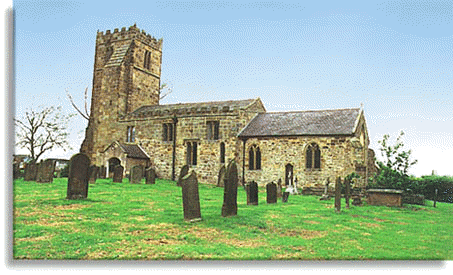


The romantically named DANBY WISKE dates back to Saxon Times, when it was known as Denebi. It is about three miles north-west of Northallerton and is reached by a narrow road forking from the Darlington road. It stands near the river Wiske, whose name comes from the Old English 'wisc' meaning a 'damp meadow.' The marshy country seems to have taken to itself the red cottages and the grey church beyond.
There is a Village Green, a nice pub, and Danby Wiske is on the route of the 190 mile long Coast To Coast Walk.
The church is unusual in that the dedication is unknown; the records were apparently destroyed when the Scots raided the North in the C12th.
The rubble walls and the doorway south of the nave are part of the early Norman aisleless building, though an Early English and Perpendicular windows have been added. The clerestory and the tower, which is large in proportion to the rest and has a wide stair-turret, are Perpendicular.
The lower part of the porch is old, and has stone benches. In it is the interesting south doorway, which has a tympanum*. A large figure in the centre, takes something from a smaller figure on his left; a figure on his right wears a dress with the long hanging sleeves of the period, it is supposed to represent the weighing of the soul. The central figure is the 'Angel of Judgement' holding with one hand a soul which has been brought in to receive judgement. In the other hand he holds a balance; in one scale are the good deeds of the deceased and in the other scale his evil deeds. The latter scale is the heavier and the prisoner is just about to be sentenced when the 'Angel of Mercy' slips his finger under the scale heavily laden with sins and causes the other scale to descend. Thus the prisoner is acquitted.
Another train of thought suggests the figures are symbolic depicting the parable of ‘The wise and foolish virgins’. The central figure representing the bridegroom (Christ), that on the left, the foolish virgins and that on the right a wise virgin. It was probably intended to give the message 'WATCH THEN, FOR YOU DO NOT KNOW THE DAY OR THE HOUR' (Matt. 24:13)The tympanum is there to remind the congregation as they enter that the day of judgement is inevitable; and unless the 'Angel of Mercy' (Jesus Christ) saves them, the evil deeds of life will weigh so heavily against them as to ensure just condemnation.
*Tympanum: the vertical recessed face of a pediment, often adorned with sculpture.
The interior has the charm of simplicity. The north arcade is Decorated, but the aisle was altered and windows inserted in the Perpendicular period. The chancel arch is almost the width of the nave, and the piers slope inwards to the ground. It and the chancel are Decorated, but the east window is restored. There is a piscina with shell bowl in the chancel, and an aumbry near it has a top stone of part of a 13th century tomb-slab, incised with a book and part of a sword.
Jacobean carved pews, one dated 1640, remain at the west end, and fragments are in the tower, the choir stalls, and behind the altar. The large circular font is Norman.
The life-size Effigy of Matilda, widow of Brian Fitz Alan of Bedale c.1340 was once the cover of her tomb, and has small shields sculptured on her dress. It was used for many years as the lintel over the door leading to the bell tower. It is said the bell-ringers got tired of bumping their heads and chipped away part of the stone. A faculty dated 14 February 1939 authorised its removal to its present position.
Brian Fitz Alan 1243-1306AD was Lord of Bedale and eventually Custodian of the Realm of Scotland. Effigies of himself and his first wife Muriel are in St. Gregory’s Church, Bedale. Matilda was his second wife and opinions vary as to her ancestry. One source suggests that she was a daughter of John Balliol, King of Scotland, whose wife was Isabella, daughter of John de Warenne, Earl of Surrey.
There are grooves on the outer walls where arrows and swords have been sharpened. The Battle of the Standard was fought nearby soon after the church was built; and Cromwell spent a night at nearby Yafforth. Memories of old battles and feuds seem to linger in the district, revived by the sight of the moat which still surrounds the rectory on the south of the church.